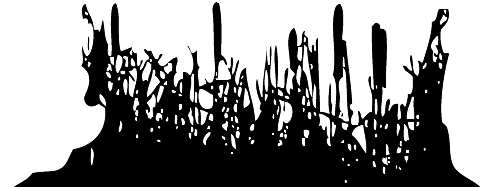Français
Finding Our Talk Season One
- Episode 1: Language Among the Skywalkers: Mohawk
- Episode 2: Language Immersion: Cree
- Episode 3: The Trees are Talking: Algonquin
- Episode 4: The Power of Words: Inuktitut
- Episode 5: Words Travel On Air: Attikamekw/Innu
- Episode 6: Language in the City: Ojibway/Anishinabe
- Episode 7: Getting Into Michif: Michif
- Episode 8 : Plains Talk: Saulteaux
- Episode 9: Breaking New Ground: Mi'kmaw
- Episode 10: A Silent Language: Huron/Wendat
- Episode 11: The Power of One: Innu
- Episode 12: Syllabics: Capturing Language: Cree
- Episode 13: A Remarkable Legacy: Saanich
Finding Our Talk Season Two
Finding Our Talk Season Three
Episode 13: A Remarkable Legacy - Saanich
This episode tells the story of Dave Elliott, a Saanich fisherman who almost single-handedly resurrected the dying language of his people - Sencofen - by creating an alphabet system, recording the elders and developing a language curriculum for local schools. Though Dave Elliott passed away in 1985, his remarkable legacy lives on in the efforts of his son John, and daughter Linda, teachers and language activists who are pioneering innovative computer programs and materials for teaching the Sencofen language.
Background
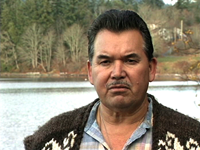 Sencofen is part of the Coast Salish family of First Nations’ languages. Its speakers belong to the Saanich nation and occupy several communities on the southern end of Vancouver Island. The decline of the Sencofen language dates back to the early part of this century, when federal regulations were introduced forbidding the Saanich people from fishing, hunting and food gathering over their traditional lands. Families who were struggling to survive had their children taken away to the residential school on Kuper Island, in the Georgian Straight north of Victoria. Saanich culture and language were suppressed and soon, as with Native communities across the country, a gap had developed between the elders in the village who still spoke their language, and their children who were being assimilated into the white education system.
Sencofen is part of the Coast Salish family of First Nations’ languages. Its speakers belong to the Saanich nation and occupy several communities on the southern end of Vancouver Island. The decline of the Sencofen language dates back to the early part of this century, when federal regulations were introduced forbidding the Saanich people from fishing, hunting and food gathering over their traditional lands. Families who were struggling to survive had their children taken away to the residential school on Kuper Island, in the Georgian Straight north of Victoria. Saanich culture and language were suppressed and soon, as with Native communities across the country, a gap had developed between the elders in the village who still spoke their language, and their children who were being assimilated into the white education system.
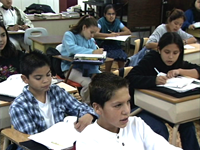 Part 1
Part 1
John Elliot
"I work at the school teaching our language at the Lauwelnew Tribal School, and our school offers all the same curriculum as any provincial school in B.C., and the only other difference we have there, is what we offer in our Sencofen language program. Sencofen is the name of our language. We offer the language from nursery school to grade nine.
Its not my first language, because, many of our people my age were not speaking the language. And so I’ve been trying to learn everything I can about that language in the last 25 years. So that I can be of some kind of help to help our language survive in this day and age."
The vibrant culture of the Saanich is rich in art, songs and stories. But its also a people struggling to preserve their language.The local Lauwelnew tribal school caters to two hundred students from the four bands on the Saanich area. Its a private band operated school where the revitalization of Saanich language and culture is taking place.
The decline of the Sencofen language dates back to the early part of the 20th century when federal regulations were introduced forbidding the Saanich people from fishing, hunting, and food gathering over their traditional lands. In addition their children were taken away to the residential school. As a result the Saanich culture and language were suppressed creating a gap developed between the elders and their children. Today only 15 fluent speakers remain.
Today, the recording of the Sencofen language in written form is playing an important role in its preservation. The unique orthography that the students are presently learning was developed was developed by the late dave elliot, a saanich elder who devoted the last years of his life to single handedly devising the sencofen alphabet.
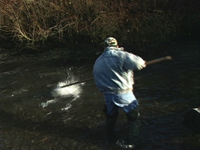 Part 2
Part 2
The traditional territory of the Saanich people is today infringed upon by the suburban expansion of the neighbouring city of victoria. Highways and traffic constantly cut through their lands. Even one of their sacred areas is now a provincial park.Here at the Gold Stream Park, amongst the old growth, the chum salmon of the pacific still come to spawn here every year. As they’ve done for centuries, the Saanich people also come here to harvest the salmon.
The salmon is an important role in the Saanich way of life. Most of the main salmon of the season is caught in the straits, but this stream is the only waterway where the salmon come to spawn in the Saanich territory. This is the last run of the season.
Dave Elliott was a Saanich fisherman, born in 1910 on the Tsartlip reserve on Southern Vancouver Island. He grew up fishing, and traveling the historical homeland of the Saanich, still known by their original Sencofen names, and speaking their language. He could remember how the old people lived before the language had broken down, and described the land and the life they lived as wealthy, “a virtual paradise”.
When arthritis prematurely ended Dave’s life as a fisherman, he found interim employment as a janitor at the Tsartlip Indian Day School, attended by many of the Saanich children. Recognizing the rapid decline in the use and knowledge of traditional language and culture, and realizing that without a method of recording the language, the language would eventually be lost, Dave began to write down Sencofen words phonetically.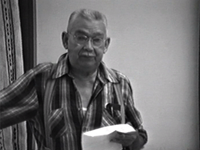
After studying with a Victoria linguist, Dave soon realized that the Roman alphabet was too unwieldy for the Sencofen language, with its complex range of sounds - a dilemma common to many First Nations’ languages, where resulting transliterated words are extremely long and complicated. So he devised his own alphabet, using only one letter to denote each sound. He purchased a used typewriter and during the winter of 1977, created the Dave Elliott Sencofen Alphabet. In 1978 the Saanich Indian School Boards adopted the alphabet in its curriculum.
We witness children making use of some of these technologies, with particular emphasis on a project especially important for John. They have taken the many lists his father wrote, most of them on paper towels, of words and letters of the language he was creating, photocopied and placed them in binders, and given them to the children to record on their computers. In this way, they are learning to write in their own language, as they simultaneously are doing the groundwork for a Sencofen dictionary.
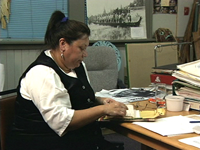 Language Keeper
Language Keeper
The Sencofen language heard in this is area of vancouver island for centuries has a handful of fluent speakers left today. The value of elders in language preservation has become a desperate situation and even more important than ever. Currently Earl is working with Linda in the creation of a comprehensive dictionary of the sencofen language.
